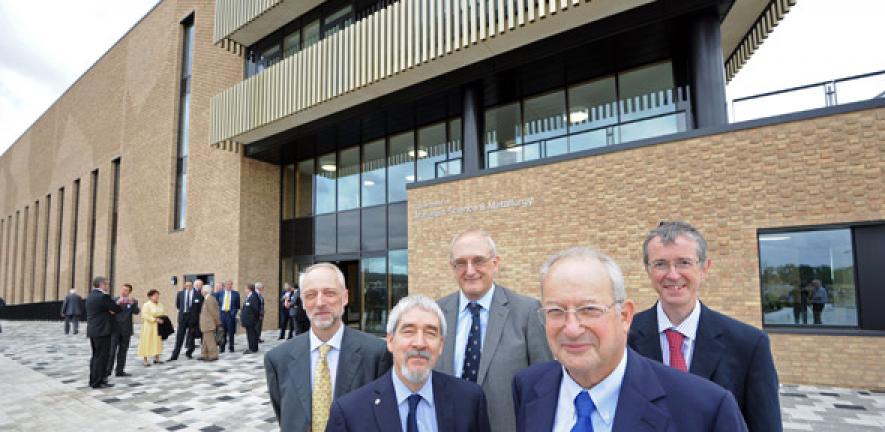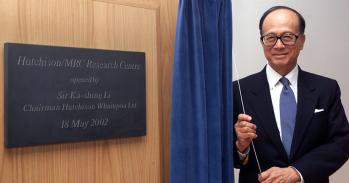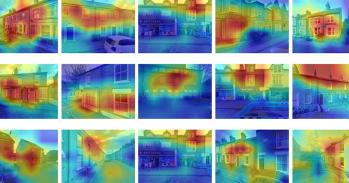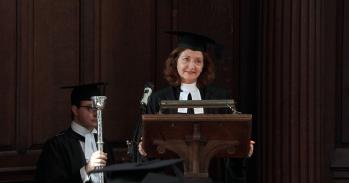
A world-leading centre for the study of and research into materials science and metallurgy has just moved into a new £48 million home on the University of Cambridge West Cambridge site.
A world-leading centre for the study of and research into materials science and metallurgy has just moved into a new £48 million home on the University of Cambridge West Cambridge site.
Pictured L-R in front of the new building: Professor Lindsay Greer, outgoing Head of Department; David Delpy, EPSRC; The Vice-Chancellor; The Chancellor; Professor Mark Blamire, incoming Head of Department
Lord Sainsbury of Turville, Chancellor of the University, officially opened the building at an event attended by the Vice-Chancellor, benefactors, and hundreds of supporters and staff.
The landmark building on the University’s growing science and technology campus has united the entire Department of Materials Science and Metallurgy under one roof for the first time.
Speaking at the Opening the Vice-Chancellor, Professor Sir Leszek Borysiewicz, said: “The University’s investment in this new building reflects the importance of the disciplines of materials science and metallurgy in our modern world, and Cambridge’s pre-eminent position in advancing them.
“Those who worked in the increasingly cramped conditions on the New Museums Site will welcome these 21st Century facilities, and the 19th Century founders of the laboratory in Sidney Sussex College – where materials science at Cambridge was born – would marvel at the discoveries now possible.”
Professor Lindsay Greer,who has just stepped down as head of department after seeing the building project through to fruition, said: “The Department is very grateful for the University’s commitment to this project. And we owe very special thanks to the external donors whose support was vital. Their generous donations, crucially augmenting the capital infrastructure funds allocated by the University of Cambridge, have made it possible for us to have bespoke facilities that will ensure that Cambridge continues to be one of the world’s leading centres for materials science for many years to come.”
Designed by the London studio of global architecture firm NBBJ, the building meets the challenge of accommodating the broad range of research fields the Department covers, from large scale processing of metals through to nanotechnology, materials chemistry and the development of medical materials.
The new facility contains a mix of laboratories, support facilities, offices and social space with a total gross floor area of 10,600 m 2.
The design maximises opportunities for collaboration and informal interaction between scientists on a daily basis, and is adaptable for future technological developments and changing research needs.
NBBJ project lead, Rebecca Mortimore, said: “A key design driver was the low-vibration requirement for the electron microscopy suite. This has influenced all aspects of the building’s design from organisation and space zoning to structural frame, building fabric and plant location. It is one of the best-adapted places for electron microscopy in the world.”
NBBJ worked very closely with the department to associate the exterior of the building with the work that goes on inside. Recessed and projecting bricks create patterns across the façade that are analogous to the grain-like microstructure of the metals being researched within the building, reinforcing the building’s identity. The brickwork patterning animates the building, making the surfaces vary as the light changes and when viewed from different angles.
A number of impressive features that will reduce energy and water consumption include:
A sophisticated mixed-mode ventilation system that provides natural ventilation for non-laboratory areas
A large photovoltaic array mounted at roof level to provide 3% of the total energy use of the building
An intensive green roof, planted with wild flowers, and rain water harvesting.
Benefactors who made the building possible are:
The Ann D Foundation
The Armourers and Brasiers’ Gauntlet Trust
Ms Anne Glover CBE
The Wolfson Foundation
The Worshipful Company of Goldsmiths
The Department of Materials Science and Metallurgy’s research grant income exceeds £9 million a year, almost 70% coming from the European Commission and the UK’s Engineering and Physical Sciences Research Council (EPSRC).
The Department’s track record of successfully addressing industrial challenges means that almost a quarter of its research income comes from partnerships with private companies.
The Department researchers are currently engaged with more than 100 collaborations, of which more than 80 are with universities, national laboratories and research institutes outside the UK.
NBBJ is an award-winning global design and architecture firm that helps clients capitalise on the relationship between people and design to enhance organisational performance. NBBJ’s London office has partnered with many of the world’s top research institutions, including the University of Cambridge, the Wellcome Trust and Kings College London. Expertise encompasses multiple disciplines, with architects, laboratory specialists, economists and sustainability experts working as a single creative force - leveraging the latest thinking within the global practice - to deliver innovative, performance-based research environments.
This work is licensed under a Creative Commons Licence. If you use this content on your site please link back to this page.





